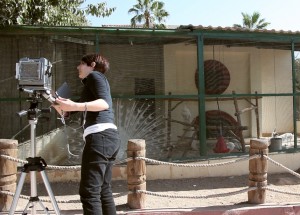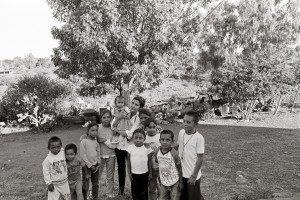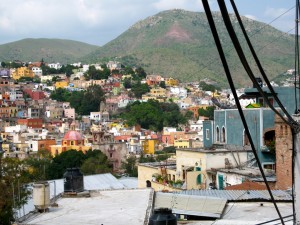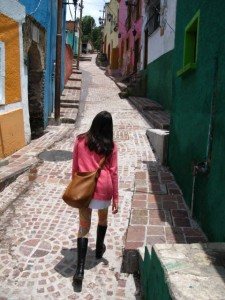
Regina Mamou, 2009-2010, Jordan, photographing on location in Shmeisani’s Prince Hashem Bird Garden, assisted by Bradley Heinz and Andrew Boylan (image by Regina Mamou).
My Fulbright journey in the visual arts began more than one year before I left for Amman, the capital city of Jordan. I first identified Jordan as the country to which I wanted to apply in June 2008 for the 2009-2010 Fulbright competition. Since graduating from the School of the Art Institute of Chicago (SAIC) with a Master of Fine Arts in Photography in 2007, I maintained connections with the Fulbright Program Adviser (FPA) at SAIC and with professors in photography, my field of study. Even though I applied At-Large, these individuals met with me on a regular basis to review my Statement of Grant Purpose and Personal Statement, and helped flesh out my research interests. I also formed an off-campus Fulbright group with three other SAIC students, which was a fruitful product of the application process. As a group, we met a few times each month to review our writing samples and offer one another support before the application deadline.
My interest in Jordan stems from my Middle Eastern heritage as my father was born and raised in Iraq. He was the first person in his family to immigrate to the United States. My extended family moved to Amman, Jordan, before they, too, eventually immigrated to the United States in the 1990s. Memory is an inherent quality of photography and I was interested in connecting with Jordan, a place that held familial significance. I began to conduct research on memory studies and navigation in Amman and was drawn to a weekly Internet-based column entitled, “Urban Crossroads,” by Mohammad al Asad, the founding director of the Center for the Study of the Built Environment (CSBE) in Amman. Reading these online articles allowed me to make abstract associations to the city, such as the fact that Amman only recently implemented house and street number addresses, and that residents have traditionally used a memory-based navigation system. This discovery led me to construct a Fulbright project about exploring navigational methods as a metaphor for interpreting a contemporary city, in addition to considering issues of architecture, urban planning, and population growth.




